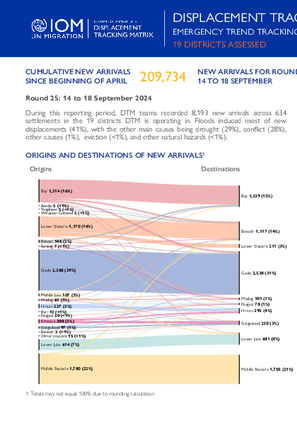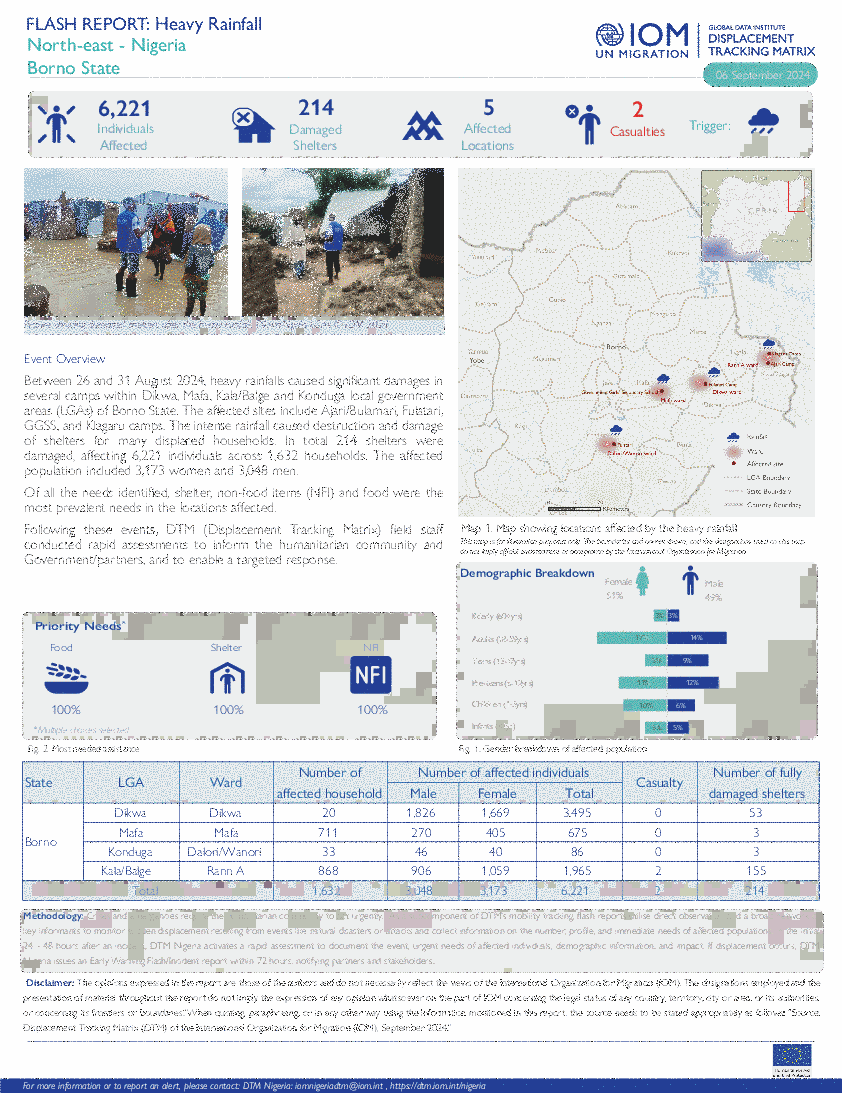-
Countries
-
Data and Analysis
-
Special Focus
-
Crisis Responses
Mobility Tracking

Contact
dtmlebanon@iom.int
Language
English
Location
Lebanon
Period Covered
Oct 10 2023
Sep 25 2024
Activity
- Mobility Tracking
- Baseline Assessment
Since October 8 there has been an increase in cross-border incidents between Israel and Lebanon, resulting in the displacement of people both within the South and elsewhere within the country. Since October 10, the Displacement Tracking Matrix (DTM) has been conducting the daily monitoring of population movements. The objective of the exercise is to inform preparedness and response planning.

Contact
DTM Mozambique, DTMMozambique@iom.int
Language
English
Location
Mozambique
Snapshot Date
Sep 26 2024
Activity
- Mobility Tracking
- Baseline Assessment
As of December 2023, there are 709,529 IDPs across 264 locations in Northern, Central and Southern Mozambique, primarily in Cabo Delgado province (76%). Two thirds of Cabo Delgado’s IDPs were displaced between 2020 and 2021, with 82 per cent experiencing multiple displacements. Other provinces such as Niassa also have high rates of protracted displacement, underscoring the critical importance of prioritizing integration as a viable solutions pathway for IDPs. Returnees mainly settle in districts of Cabo Delgado due to restored security, available land for farming, and family reunification. Overall, the rate of return movements in Mozambique has dwindled due to resurfacing violent attacks.

Contact
DTM Mozambique, DTMMozambique@iom.int
Language
English
Location
Mozambique
Snapshot Date
Sep 26 2024
Activity
- Mobility Tracking
This report presents a deeper country-specific dive into the findings of the qualitative analysis of seven focus group discussions conducted between 1 and 15 August 2023 in Guara Guara and Macomia with 103 representatives of IDPs, host community, and returnees. Over two thirds (65%) of the respondents were female. Seventy-two per cent of respondents were between the age of 18 and 59, and the remaining 20 per cent were older than 60 years and 8 per cent were under the age of 17.

Contact
iomaccra@@iom.int
Language
English
Location
Ghana
Period Covered
Sep 08 2024
Sep 11 2024
Activity
- Mobility Tracking
Rising water levels upstream from the Akosombo Dam, primarily due to heavy rainfall caused the Volta River Authority to spill excess water on 15 September 2023. The spillage has caused flooding in communities downstream of the dam, destroying homes and farmland along the banks of the River Volta. Therefore, some communities were displaced into safe havens (also known as collective centers) in the districts of Ada East, Central Tongu, North Tongu and Shai Osudoku.
To update population figures in the safe havens, the National Disaster Management Organization (NADMO), with technical and financial support of the International Organization for Migration (IOM), deployed the DTM-developed Standard Registration Tool. This initiative, carried out in collaboration with the World Food Programme, World Vision and the Ghanaian Federation of Persons with Physical Disabilities, took place between 14 and 17 November 2023. Thirty enumerators conducted registrations across 25 safe havens in the affected districts, recording over 7,000 internally displaced persons (IDPs) from 1,492 households. The deployment provided detailed data and an in-depth analysis of the specific needs of these households.

Contact
MTM Tajikistan (mtmtajikistan@iom.int); DTM REMAP Support Team (dtmremapsupport@iom.int)
Language
English
Location
Tajikistan
Period Covered
Jan 01 2024
Jun 30 2024
Activity
- Flow Monitoring
- Mobility Tracking
This report aims to provide an overview of the migration patterns and mobility in Tajikistan, drawing upon data from the latest available sources between January to June 2024 from national and international datasets on migratory movements concentrating on the most recent migration situation in Tajikistan. This includes migration flow, number of residences permits and remittances, as well as reasons for migration. The report includes the continuing impact of the Russian invasion of Ukraine on traditional migration corridors in the region, changing labour migration flows, increase of climate change and migration concerns, the growing urbanization process, the social-economic circumstances, and other major events described as main contributing factors of the human mobility and migratory movements in the given period in the country. Additionally, the report also narrates the impacts of the tragic incident on the Crocus City Hall in Krasnogorsk near Moscow carried out on 22 March 2024 by Islamic State-Khorasan (ISIS-K), which involved Tajik migrants as perpetrators on migratory movements.

Contact
MTM Kazakhstan (mtmkazakhstan@iom.int) DTM REMAP Support Team (dtmremapsupport@iom.int)
Language
English
Location
Kazakhstan
Period Covered
Feb 15 2024
Apr 30 2024
Activity
- Survey
- Return Intention
- Mobility Tracking
- Baseline Assessment
DTM implements the Baseline Mobility Assessment (BMA) in Kazakhstan to track mobility, provide information on population estimates, geographic distribution of migrant workers, return migrants, and emigrants, reasons for migration and countries of origin, return, and destination. Data is collected at the community (micro districts, townships, and villages) level from key informants and direct observations.
The Baseline Mobility Assessment (BMA) was conducted in seven oblasts or provinces (Abay, Almaty, Kostanay, Kyzylorda, Mangystau, North Kazakhstan, and Turkestan), and three major cities of Kazakhstan namely Shymkent city, Almaty city, and Astana city. This assessment covered 1,301 communities through interviews with 1,923 key informants. Based on the key informants' estimates, 598,094 international migrant workers were hosted in the assessed locations in Kazakhstan from 2020 to April 2024. Concurrently, 29,853 internal migrants were hosted in the assessed locations, and 3,224 Kazakh nationals were reported to be residing abroad as international migrants. In addition, 17,317 Kazakh migrants have returned from abroad.

Contact
DTM DRC, iomdrcdtm@iom.int
Language
English
Location
Democratic Republic of the Congo
Period Covered
Jun 01 2024
Aug 31 2024
Activity
- Mobility Tracking
- Baseline Assessment
The Democratic Republic of the Congo (DRC) has a complex internal displacement situation with a diverse set of drivers and impacts. In the country’s eastern provinces, armed conflict and insecurity have long been the primary drivers of the large-scale protracted displacement that the region experiences. On top of the large-scale humanitarian crisis in the east of the country, other regions of the DRC have experienced conflict, insecurity, and disasters such as floods and landslides. A complete understanding of the displacement situation across the entire DRC is vital to inform both near-term humanitarian assistance, as well as engaging a wider array of stakeholders involved in long-term programming. This report presents an updated country-level displacement overview produced by DTM in the DRC and combines data from targeted Mobility Tracking (MT) in the country’s four eastern provinces (conducted between July and August 2024) as well as from a separate exercise (known as MT Light), covering the remaining 22 provinces, for which data was collected between June and July 2024.

Contact
DTM Somalia, IOMSomaliaDTM@iom.int
Language
English
Location
Somalia
Period Covered
Sep 14 2024
Sep 18 2024
Activity
- Mobility Tracking
- Baseline Assessment
This latest round of Emergency Trends Tracking was initiated in April 2024 to monitor displacements movements during the Gu rainy season. Districts covered in this round include Afgooye, Afmadow, Baardheere, Baidoa, Balcad, Belet Weyne, Belet Xaawo, Cabudwaaq, Dayniile, Dhuusamarreeb, Doolow, Gaalkacyo, Garoowe, Hodan, Jamaame, Jowhar, Kahda, Kismaayo, and Luuq. ETT is a crisis-based tool that tracks sudden displacement triggered by specific events or emerging crises.
The objective of ETT is to help prioritize humanitarian response and to enable partners to deliver rapid assistance. Based on previous shock induced displacement patterns, the humanitarian community expects that people will continue to move toward urban areas in search of humanitarian services. Consequently, the ETT coverage focuses on the main urban centers and surrounding villages for each assessed district. The data is collected through Key Informant Interviews (KIIs) at the location level, from Sunday to Wednesday every week. It includes information on new arrivals, numbers and demographic of IDPs, reasons for displacement, intentions, humanitarian assistance and priority needs among others.
To facilitate the joint analysis of the CCCM (Camp Coordination and Camp Management) Cluster’s New Arrivals Tracker (NAT) and ETT data, the assistance and needs indicators are identical in both tools.

Contact
DTM Nigeria, iomnigeriadtm@iom.int
Language
English
Location
Nigeria
Period Covered
Aug 26 2024
Sep 01 2024
Activity
- Mobility Tracking
- Event Tracking
Between 26 August and 1 September 2024, a total of 24 new arrivals were recorded at locations in Benue State. The new arrivals were recorded in Guma, Gwer west and Kwande local government areas (LGAs) of Benue State.

Contact
DTM Nigeria, iomnigeriadtm@iom.int
Language
English
Location
Nigeria
Period Covered
Aug 26 2024
Aug 31 2024
Activity
- Mobility Tracking
- Event Tracking
Between 26 and 31 August 2024, heavy rainfalls caused significant damages in several camps within Dikwa, Mafa, Kala/Balge and Konduga local government areas (LGAs) of Borno State. The affected sites include Ajari/Bulamari, Fulatari, GGSS, and Klagaru camps. The intense rainfall caused destruction and damage to shelters for many displaced households. In total 214 shelters were damaged, affecting 6,221 individuals across 1,632 households. The affected population included 3,173 women and 3,048 men.
Pagination
- Previous page
- Page 22
- Next page
